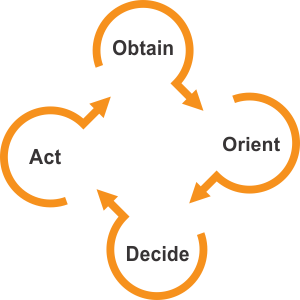Author’s Corner
In his white paper, Mark Kausel, Senior Director of Client Success, provides insight into automation and revenue cycle management (RCM). He also analyzes the downsides of “quick fix” RCM technology other vendors sell.
Please click on the video to the right to learn more about Mark, his paper’s key takeaways, and his motivation for writing on this subject.
To discuss RCM technology at length, please contact Mark using his information provided at the bottom of the white paper.
Revenue cycle management continues to grow more complex. There are ever-changing regulations, the ongoing transition to value-based reimbursement (VBR) models, different requirements by payers, and the pressure by healthcare organizations to maximize cash collections.
Everyone is being asked to do more with less, and provider organizations are seeking to minimize back-office staff with more patient-facing, revenue-generating team members. As investments in clinical systems stabilize from the mad rush of “Meaningful Use,” organizations are turning to apply technology in financial areas.
According to a study of provider executives published by HFMA and Navigant in September 2019, 69% of executives are projecting their revenue cycle management information technology budgets will grow in the next year.
In that same study, 15% of health system executives are targeting robotic process automation (RPA) versus 0% in 2018.

Understanding Technology
As organizations turn to technology to assist in addressing the increasing complexities in revenue cycle, there is so much to learn and consider. Implementing technology alone can be very effective or have dire consequences. As complex as revenue cycle management is growing, so too is technology. Everyone has a widget they tout that will fix your problems. One must be skeptical and informed.
A search on revenue cycle technologies will find many vendors promoting their systems with terms (and acronyms) like robotic process automation (RPA), artificial intelligence (AI), machine learning (ML), business intelligence/analytics (BI/BA), natural language processing (NLP), and computer-assisted coding (CAC), to name a few. There is no standard definition of terms, so clearly comprehending what a solution can do is important. Claims that technology will improve efficiencies and revenue integrity are true— if implemented properly. Recognize there is no quick fix, and technology alone will not solve the problem.
Let us consider four technologies that organizations are in various stages of deploying – big data analytics, robotic process automation, machine learning, and artificial intelligence. Since there are no standards, definitions must be agreed upon, so everyone is on the same page and comparing “apples to apples.”
The OODA Loop, developed by American fighter pilot and tactician Colonel John Boyd, can be used to compare the differences in the four technologies listed previously. This model can be considered an abstraction of the typical human thought process.
To simplify, we Observe, Orient, Decide, Act, and repeat. Evaluating big analytics, robotic process automation, machine learning and artificial intelligence using this model can help differentiate the benefits each technology can deliver to the revenue cycle management process.

Big Data Analytics
examines large amounts of data to analyze hidden patterns, correlations and other insights. Analytics is a powerful tool for identifying correlations, but not causation. One is able to see patterns and trends, but a human must interpret the data to make a decision. In the OODA model, Big Data Analytics Obtains information, but does not Orient, Decide, or Act on it. Decisions and actions are executed through human intervention.
Robotic Process Automation
is used in frequently repeated processes, mimicking a human interacting with a computer or computers. RPA is instructed, or trained, by a human on what actions to take. It is following a set of rules or instructions based on what a human told it to do. In OODA terms, RPA Obtains data and takes Action, but does not Orient or Decide.
Machine Learning
uses computer algorithms to build a mathematical model based on “training data” in order to make predictions or decisions without being explicitly programmed to do so. It is a subset of artificial intelligence. Because a human has “trained” it, we know what is right and wrong. Machine Learning can be taught to Obtain, but not Orient, Decide, or Act in terms of OODA. The limitations of Machine Learning are based on what a human has trained it to do.
Artificial Intelligence
according to Wikipedia, “… any device that perceives its environment and takes actions that maximize its chance of successfully achieving its goals.” AI can be trained to make decisions and take action as appropriate. If given a goal, AI will work to achieve it, but it will take many iterations (correct and incorrect) to solve and requires constant feedback. Successfully deploying AI requires large amounts of data for it to learn and apply information correctly. But over time, IT will be a very effective tool. In the OODA model, AI can Obtain, Orient, Decide, and Act.
Best approach to Deploying Technology in Revenue Cycle
Significant value can be seen by leveraging technology in the revenue cycle workflows. Success will be driven by the resources organizations utilize. Vee Healthtek offers world-class professional services supplemented by technology. Our revenue cycle management resources offer best-practice knowledge, coupled with deploying technology to support healthcare organizations.
Technology is a tool to be used to support organizational goals. Within revenue cycle departments, technology can be used to effectively manage the complexities encountered by variations in payers and regulatory requirements. A good first step is to augment core systems with complementary technologies or capabilities to support internal collaboration between different departments or teams. Our experience with high-performing revenue cycle operations leverages technology to automate processes that allow staff to focus on areas where their expertise has the most impact.
Whether you choose Big Data Analytics, Robotic Process Automation, Machine Learning, Artificial Intelligence, or a combination of them, ensure you are aligning the goals for the technology with the organizational outcomes you desire. Invest the time and money in the technology.
As patient care becomes more complex, so does the revenue cycle. Seek solutions that will simplify and manage the complexity. Consider vendors’ core competencies when evaluating solutions and look for integration and intelligent automation that will deliver the most value to your organization.
Healthcare Financial Management Association and Navigant. (September 2019). Revenue Cycle Technology Trends: A survey of provider executives about the impact of EHRs, consumer self-pay, and IT budgets on revenue cycle operations.
Wikipedia. https://en.wikipedia.org/wiki/Machine_learning
Wikipedia. https://en.wikipedia.org/wiki/Artificial_intelligence

